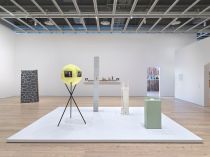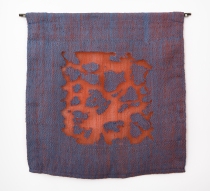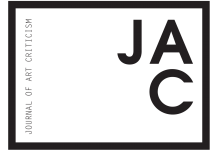Author Archives: Journal of Art Criticism
Pierre Huyghe: “UUmwelt,” the space between humanity
By Max Gruber, Swarthmore College A torso with six eyes like robin’s egg shells is buffeted by a virtual breeze across a grainy, barren landscape. A rose-colored bulb props up a wrinkled yellow membrane flanked on each side by
Pierre Huyghe: “UUmwelt,” the space between humanity
By Max Gruber, Swarthmore College A torso with six eyes like robin’s egg shells is buffeted by a virtual breeze across a grainy, barren landscape. A rose-colored bulb props up a wrinkled yellow membrane flanked on each side by

Review: Rachel Harrison, “Life Hack”
By India Halsted, Barnard College As part of JAC’s push to integrate more digital content in accordance with our 2020 journal theme, “New Media, New Messages,” we are thrilled to present this online-only exclusive. Here, our very own Events Coordinator,

Review: Rachel Harrison, “Life Hack”
By India Halsted, Barnard College As part of JAC’s push to integrate more digital content in accordance with our 2020 journal theme, “New Media, New Messages,” we are thrilled to present this online-only exclusive. Here, our very own Events Coordinator,

Self-Portrait
Self-Portrait, 2017 Archival pigment print By Vibhav Kapoor, University of California, Irvine Originally published in the 2019 print edition.

Self-Portrait
Self-Portrait, 2017 Archival pigment print By Vibhav Kapoor, University of California, Irvine Originally published in the 2019 print edition.
Deana Lawson’s Exalted Black Subjects
By Nicole-Ann Lobo, Columbia University. Originally published in the 2019 print edition. As a linguistic act, place-naming seems to tame spatial ambiguity by exerting a sense of ownership and control over a domain. But still there remain nameless places that
Deana Lawson’s Exalted Black Subjects
By Nicole-Ann Lobo, Columbia University. Originally published in the 2019 print edition. As a linguistic act, place-naming seems to tame spatial ambiguity by exerting a sense of ownership and control over a domain. But still there remain nameless places that

Untitled
Untitled, 2019 Paper mâché and found objects. By Aimee Lyons, Goldsmiths College, University of London Originally published in the 2019 print edition.

Suspension
Suspension, 2018 Graphite on bristol By Daniel Stroh, Metropolitan State University of Denver Originally published in the 2019 print edition.

Suspension
Suspension, 2018 Graphite on bristol By Daniel Stroh, Metropolitan State University of Denver Originally published in the 2019 print edition.
In Which Humanness Rests
By Oscar yi Hou, Columbia University. Originally published in the 2019 print edition. 1. Negative Space “My relationship to my paintings are like my relationships to people.” (Jennifer Packer, 2017)1 Subjects melt into red earth in Graces, a painting of
In Which Humanness Rests
By Oscar yi Hou, Columbia University. Originally published in the 2019 print edition. 1. Negative Space “My relationship to my paintings are like my relationships to people.” (Jennifer Packer, 2017)1 Subjects melt into red earth in Graces, a painting of

Infertile Soil
Infertile Soil, 2018 Cotton-nylon hand-woven cloth with screen printed devoré burnout By Mary Champagne, Maryland Institute College of Art Originally published in the 2019 print edition.

Infertile Soil
Infertile Soil, 2018 Cotton-nylon hand-woven cloth with screen printed devoré burnout By Mary Champagne, Maryland Institute College of Art Originally published in the 2019 print edition.
Lee Ufan and the Art of Margins
By Allison Yoo, Barnard College. Originally published in the 2019 print edition. Lee Ufan was a Korean-born artist, working primarily in Japan beginning in 1956.1 Throughout his career, Lee participated in multiple art movements, though he is most well known
Lee Ufan and the Art of Margins
By Allison Yoo, Barnard College. Originally published in the 2019 print edition. Lee Ufan was a Korean-born artist, working primarily in Japan beginning in 1956.1 Throughout his career, Lee participated in multiple art movements, though he is most well known

